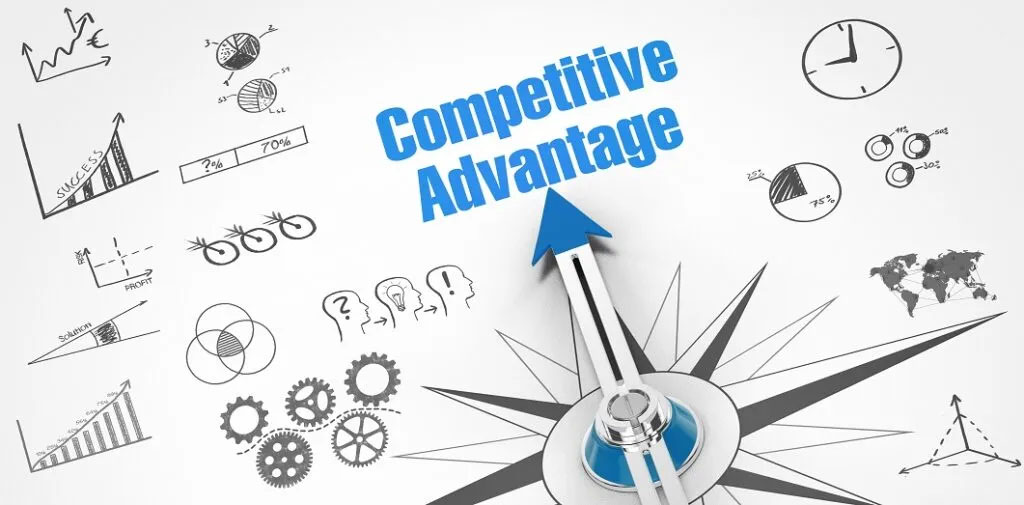

Competitive Advantage
Competitive Advantage
What is Competitive Advantage?
Lorem ipsum dolor sit amet, consectetur adipiscing elit. Suspendisse varius enim in eros elementum tristique. Duis cursus, mi quis viverra ornare, eros dolor interdum nulla, ut commodo diam libero vitae erat. Aenean faucibus nibh et justo cursus id rutrum lorem imperdiet. Nunc ut sem vitae risus tristique posuere.
What Does Competitive Advantage Mean in Marketing?
In marketing, competitive advantage is a term that refers to the unique set of strengths, attributes, or capabilities that differentiates a company, product, or service from its competitors in the marketplace. It is the advantage a business has over its rivals, enabling it to outperform them, attract customers, and achieve sustainable success. Competitive advantage can manifest in various forms, such as superior product quality, lower prices, exceptional customer service, innovative features, efficient processes, or strong brand reputation.
The Importance of an 'Unfair' Competitive Advantage.
Having a superior performance is essential in today's highly competitive commercial landscape. Building an unfair competitive advantage, which is difficult to copy, enables companies to stand out in the market, capture market share, and thrive in the long term. By effectively leveraging their core capabilities and distinguishing themselves from competitors, businesses can create a strong value proposition and attract more customers who perceive them as offering superior value.
What is a Sustainable Competitive Advantage?
A sustainable competitive advantage refers to a long-term strategic advantage that a company possesses over its competitors, allowing it to consistently outperform and maintain its market position. Unlike temporary or short-lived advantages, a sustained advantage endures over time, providing a firm with stability, profitability, and a solid foundation for future growth.
Key characteristics of a sustainable competitive advantage include:
- Difficulty to Replicate: A sustained competitive advantage is challenging for competitors to duplicate or imitate. It may arise from unique resources, capabilities, or strategic positions that are not easily replicated by others. This uniqueness creates a barrier to entry and protects the company's market position.
- Value Creation: A sustainable competitive advantage enables a company to create superior value for customers. It offers something that customers perceive as valuable and differentiates the company's products or services from those of competitors. This value creation results in customer loyalty, repeat business, and a competitive edge in the market.
- Durability: A sustainable competitive advantage is durable and can withstand changes in the business environment, evolving customer preferences, or technological advancements. It is not easily eroded or nullified by external factors, providing the company with a long-term advantage and stability.
- Alignment with Core Capabilities: A sustainable competitive advantage is closely aligned with a company's core competencies, which are its unique strengths and capabilities. It leverages the company's core competencies to deliver superior value and meet customer needs effectively. This alignment enhances the sustainability of the advantage.
5 Sources of Sustainable Competitive Advantage .
There are many sources of gaining a competitive advantage, but here are a few common examples:
- Intellectual Property: Companies that hold patents, copyrights, trademarks, or trade secrets have legal protection and exclusivity over their inventions, creations, or brands. This intellectual property can provide a sustainable advantage by preventing competitors from using or replicating the protected assets.
- Strong Brand Equity: A well-established and strong brand identity builds trust, credibility, and customer loyalty. Brand equity creates a sustainable advantage as customers associate the brand with positive experiences, quality, and value, making it difficult for competitors to displace the brand in the minds of consumers.
- Economies of Scale: Companies that achieve economies of scale by producing goods or services at a lower cost per unit enjoy a sustainable cost advantage. Larger production volumes allow them to spread fixed costs, negotiate better supplier contracts, and invest in efficient operations, creating a barrier for new entrants.
- Access to Distribution Channels: Companies that have established and exclusive distribution channels or partnerships with key retailers gain a sustainable advantage. This enables them to reach customers effectively, control market access, and limit the reach of competitors.
- Network Effects: Companies that benefit from network effects, where the value of a product or service increases as more users join the network, have a sustainable competitive advantage. This advantage arises from the difficulty of replicating the network and the value it provides to users.
In summary, a sustainable competitive advantage is a long-term strategic advantage that enables a company to outperform its competitors consistently. It is difficult to replicate, creates value for customers, endures over time, and aligns with the company's core competencies. Companies that can establish and maintain a sustainable competitive advantage are well-positioned for long-term success and profitability in their respective markets.

"Competitive advantage is the unique set of strengths that sets a company apart from its rivals, enabling it to outperform and attract customers. It creates value, endures over time, and aligns with core capabilities for long-term success. This must be at the top of every CMOs mind."
Paul Mills
Founder, VCMO
Types of Competitive Advantage Strategies.
There are several different ways to gain a competitive advantage that businesses can leverage to differentiate themselves from competitors. These types can be categorised into the following:
Cost Leadership
This type of competitive advantage is achieved when a business can produce and offer its products or services at a lower cost compared to its competitors. Cost leadership can stem from factors such as economies of scale, efficient supply chain management, advanced technology, or access to cheaper resources. By offering lower prices, businesses can attract price-sensitive customers and gain a competitive edge.
Differential Advantage
Differentiation advantage is achieved when a business can offer unique and superior products, services, or features that are valued by customers. This can be achieved through product innovation, superior quality, exceptional customer service, customisation options, or a strong brand image. Differentiation advantages allow businesses to charge premium prices and attract customers who seek unique or superior offerings.
Focus Strategy
Focus advantage is based on targeting a specific niche market or a specific customer segment. By concentrating on a specialised market, businesses can develop expertise, tailor their offerings to meet specific customer needs, and build strong relationships. This type of advantage is often achieved by understanding the unique requirements of the target market and providing specialised products, services, or experiences that are not easily replicated by broader competitors.
Technological Advantage
Technological advantage arises from a company's ability to leverage advanced technology, proprietary systems, or intellectual property. This advantage can be in the form of patents, trade secrets, or exclusive licenses that provide a technological edge over competitors. Technological advantages allow businesses to develop innovative products, streamline processes, enhance efficiency, or provide unique features that competitors may find challenging to replicate.
Brand Advantage
Brand advantage is built on a strong brand identity, reputation, and customer loyalty. When customers have a positive perception of a brand and associate it with quality, reliability, or other desirable attributes, it creates a competitive advantage. Strong brands can command premium prices, attract loyal customers, and withstand market fluctuations more effectively than lesser-known brands.
Operational Advantage
Operational advantage is achieved through operational efficiency, effective processes, or superior supply chain management. This advantage allows businesses to reduce costs, improve productivity, streamline operations, and deliver products or services more efficiently than competitors. Operational advantages can result from factors such as superior logistics, optimised production processes, effective cost control, or innovative approaches to efficiency.
It is important to note that these types of competitive advantages are not mutually exclusive, and businesses can often leverage multiple advantages simultaneously. Additionally, the relevance and effectiveness of each type of advantage may vary depending on the industry, market dynamics, and specific business context. Successful companies often develop and maintain a combination of these advantages to position themselves strongly in the marketplace.
How Can I Measure My Company’s Competitive Advantage?
Measuring competitive advantage can be a complex task as it involves assessing various factors and comparing your business to competitors. Here are some key steps to help you measure your competitive advantage:
- Identify Key Performance Indicators (KPIs): Start by identifying relevant KPIs that align with your business goals and industry benchmarks. These KPIs should focus on areas where your competitive advantage is expected to have the most impact. For example, you might consider metrics such as market share, customer satisfaction, customer retention rates, revenue growth, or brand recognition.
- Conduct Market Research: Gather market intelligence and conduct competitive analysis to gain insights into your industry landscape. Understand your competitors' offerings, strengths, weaknesses, pricing strategies, marketing tactics, and customer perceptions. This will help you benchmark your performance against industry standards and identify areas where you stand out. PESTEL and Porter's Five Forces strategic frameworks can help with this.
- Customer Feedback and Surveys: Engage with your customers to gather their feedback and understand their perceptions of your competitive advantage. Conduct customer surveys, interviews, or focus groups to gain insights into why customers choose your products or services over competitors. Their feedback can provide valuable information on your unique selling points and areas for improvement.
- Comparative Analysis: Compare your business against direct and indirect competitors using relevant benchmarks and industry data. Evaluate your performance in key areas such as product quality, pricing, customer service, innovation, distribution channels, or operational efficiency. This analysis will help you gauge how you stack up against competitors and identify areas where you have a distinct advantage.
- Market Share Analysis: Assess your market share relative to your competitors. This can be done by calculating your market share percentage based on sales revenue, units sold, or other relevant metrics. A higher market share indicates a stronger competitive position.
- Pricing Analysis: Evaluate your pricing strategy and compare it with competitors. Assess whether you offer a better value proposition based on price, quality, or features. Analyse how customers perceive the value they receive compared to what they pay, and consider conducting price elasticity studies to understand the sensitivity of demand to changes in pricing.
- Brand Perception and Recognition: Measure the strength of your brand and its perception in the market. Monitor brand awareness, brand recall, and brand sentiment through surveys, online reviews, or social media monitoring. A strong and positive brand perception can be a significant competitive advantage.
- Internal Analysis: Conduct an internal analysis to evaluate your organisation's capabilities and resources. Identify your core competencies, unique skills, intellectual property, or proprietary technology that set you apart from competitors. Assess how these resources contribute to your competitive advantage.
- Track Changes Over Time: Regularly track and analyse the identified KPIs to monitor changes in your competitive advantage. Assess the impact of strategic initiatives, marketing campaigns, or product enhancements on your performance. This will help you understand the effectiveness of your efforts in maintaining or strengthening your competitive position.
- Customer and Employee Retention: Measure customer and employee retention rates as indicators of your competitive advantage. A higher customer retention rate suggests that customers perceive value in your offerings, while strong employee retention indicates a positive work environment and specialised expertise.
Remember, measuring competitive advantage is an ongoing process. Continuously monitor and analyse relevant data, gather customer feedback, and stay updated on industry trends. By understanding your competitive position, you can make informed decisions, optimise your strategies, and further enhance your competitive advantage over time.

Frameworks That Can Help Measure Competitive Advantage.
During the strategic planning process, there are several marketing tools and frameworks that can be used to measure competitive advantage. These tools provide a structured approach to analysing the competitive landscape and evaluating a company's position relative to its competitors. Here are some commonly used tools:
• TOWS analysis
• Value Chain Analysis
• VRIO framework
It is important to note that these tools should be used in conjunction with each other, and other business information, to gain a comprehensive understanding of a company's competitive advantage. Additionally, the choice of tools may vary depending on the industry, business context, and specific objectives. Utilising a combination of these tools enables businesses to assess their competitive position accurately, identify areas for improvement, and make informed strategic decisions.
Advantages of Creating a Competitive Advantage.
Developing and strengthening your company’s competitive advantage can offer a variety of benefits, including:
- Market Differentiation: A competitive advantage allows a company to differentiate its products or services from those of its competitors. It helps create a unique selling proposition that sets the business apart and provides customers with a compelling reason to choose their offerings over alternatives.
- Increased Market Share: When a company has a clear competitive advantage, it can attract a larger customer base and gain a higher market share. This can lead to increased sales, revenue, and profitability, as well as potentially creating barriers to entry for new competitors.
- Customer Loyalty and Retention: By offering something unique or superior, businesses with a competitive advantage can build strong customer loyalty. Customers are more likely to remain loyal to a brand that consistently delivers value and meets their needs. This can lead to repeat purchases, positive word-of-mouth referrals, and long-term customer relationships.
- Pricing Power: Having a competitive advantage can provide companies with the ability to command premium pricing for their products or services. When customers perceive a higher value in a brand's offerings, they are often willing to pay a premium price, which can contribute to increased profit margins.
- Innovation and Adaptability: A competitive advantage encourages businesses to continuously innovate and improve. By staying ahead of market trends, customer preferences, and emerging technologies, companies can adapt quickly to changes, maintain relevance, and continue to offer unique and compelling solutions to their target audience.
Disadvantages of Strengthening a Competitive Advantage.
Building your company’s competitive advantage is an on-going and resource intensive process. While there are obvious benefits, there are some important things to consider before investing in a program of innovation:
- Competitive Response: Competitors will often attempt to replicate or surpass a company's competitive advantage. Businesses must be prepared for competitive responses and continuously enhance their unique value proposition to stay ahead.
- Evolving Market Dynamics: Market conditions and customer preferences can change rapidly, potentially diminishing the effectiveness of a previously strong competitive advantage. Businesses need to stay vigilant and adapt their strategies to evolving market dynamics to maintain their edge.
- Replicability: Depending on the nature of the competitive advantage, it may be possible for competitors to replicate or imitate it over time. It is crucial for companies to continuously innovate and enhance their unique capabilities to sustain their advantage.
- Shifting Customer Needs: Customer needs and preferences are subject to change. Businesses must stay attuned to these changes and ensure their competitive advantage aligns with the evolving demands of their target audience.
Recap on Competitive Advantage.
Competitive advantage is a critical concept in marketing that enables businesses to differentiate themselves, attract customers, and achieve long-term success. By leveraging their unique strengths and delivering superior value, companies can gain a competitive edge in the market.
However, it is important to continuously monitor the competitive landscape, adapt to changing market dynamics, and innovate to sustain the advantage over time. A strong and well-executed competitive advantage can contribute significantly to a company's growth, market share, profitability and ultimately its enterprise value.
About VCMO
VCMO is a UK-based provider of fractional marketing services, supporting B2B SMEs—ranging from funded scale-ups to mid-tier and private equity-backed businesses—through key moments of growth and transformation. Its Chartered Fractional CMOs and SOSTAC® certified planners embed strategic marketing leadership into organisations navigating product launches, new market entry, acquisitions, and leadership gaps.
Ready to take your marketing to the next level? Let us help you get there.
Subscribe to Our Newsletter
Fractional Edge is our montly newsletter sharing expert opinion on the latest trends in fractional leadership, curated marketing content from leading sources, VCMO events, and much more. Subscribing is quick — just add your name and email.












